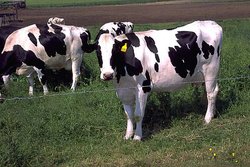Holstein (cattle)
|
|
For other uses of the word, see Holstein
The Holstein, or Friesian as it is known in the UK, is a cattle breed used in dairy farming.
Developed in what is now the province Fryslân, The Netherlands, the Holstein cattle (sometimes known as Friesian Holstein or Holstein Friesians) was imported to the United States of America in the 1860's. Thanks to the breed's flexibility, productivity, and economic production of milk, the Holstein is now the most common breed of dairy cattle around the world. The Holstein's most outstanding characteristic is its combination of a high volume of milk production at an acceptable milk fat percentage. Typical Holstein milk is 2.5% to 3% milk fat (the Jersey, another popular dairy breed, produces about half the volume of milk per cow per day, but at 4 to 4.5% milk fat).
The stereotypical cow in western entertainment and commercials, an average Holstein cow in the United States produces about 28,000 pounds (12,700 kg) of milk per annum. This is roughly equivalent to 3,250 U.S. gallons (12,300 litres)
Most Holsteins weigh 90 pounds (40 kg) at birth. Holstein cows will mature to approximately 1,400 pounds (600 kg), while Holstein bulls will reach nearly 2,000 pounds (900 kg).
The primary color pattern for this breed is black and white, but a red and white variety, called "red holstein" is also maintained.
In late 2003 a cow of this breed was found to have Bovine Spongiform Encephalopathy (BSE) Mad Cow Disease near the city of Mabton, Washington, in the United States. BSE, a brain wasting disease, can afflict all cattle, not just the Holstein variety, and is thought to also affect sheep. Under rare circumstances BSE can be transmitted to humans, where it is termed variant Creutzfeldt-Jakob disease.
Template:Mammal-stub Template:Agri-stubde:Holstein-Rind ja:ホルスタイン nl:Holstein-Friesian sv:SLB es:Vaca frisona

